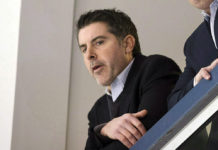
It’s the beginning of August, 2012. I—m at sitting home, at my desk, thinking about what my next piece is going to be about. Little ideas surface, but nothing quite worthy of putting on paper.
The Leafs. What is the state of Leafs Nation? Where are our expectations at? Unlike seasons past, I find it difficult to answer that question. Hope, it—s always there, but this year it doesn—t seem worthy enough of a true, better yet — honest, Leafs related story.
Is it the lack of moves by our opinionated, strong willed and loud, be it eloquently so, general manager? While the case may be that he was indeed loud in stating his belief in strengthening the current roster, that hasn—t happened with the signings of Tyler Biggs or Morgan Rielly.
Since there is still some sand left in his hourglass, it isn—t yet time to flip him and panic, not in my mind. So why is it so dry? In retrospect, I should have figured it out much sooner, that this lack of inspiration stems mainly from the fact hockey—s crown jewel, the NHL, faces yet another possible work stoppage.
Yes, as it turns out, my greatest hockey nightmare isn—t the Blue and White not making it to the show for yet another year, it—s the chance of not seeing NHL puck at all what is really starting to sink in and terrify me. Why? Well, beyond the obvious, it—s mainly because we—re Leaf fans. Now, I don—t buy that curses exist, but if one did, at it was on the Buds, wouldn—t the following season be a picture perfect chance for it to shine?
Being a Leafs fan it—s not hard to picture a scenario where the team does indeed get stronger, where we get center stage for the first time in a long time, all the lights pointed at the Winter Classic, HBO—s 24/7 and all just to make us wait. Wait a little longer.
So, I—ve put my best foot forward and started thinking about the labor negotiations between the two parties, trying to make sense of the whole thing.
Call it – the NHL, players and money, or – sports, athletes and income. The first three are inseparable much like all sports franchises, leagues and players are bonded together by a simple green piece of paper. There—s no going around it. Professionalism brought money to the table and that piece of paper has grown increasingly vital as the years have progressed. We have long passed the point of green being the color of success and have long before ventured into it being a parallel for sporting success both for franchises and athletes themselves.
Samuel Eto’o is the world’s second highest earning athlete and the highest paid footballer in the world, raking in £35.7 million (over $54 million) a year excluding off-field earnings. Also, we can argue the salary cap until we—re blue in the face and despite every other argument I—d argue that the implementation of said cap made us all smarter fans. It made us think more, contemplate more, but at the same time it put more emphasis on money (and its correlation to player performance) than ever before.
Still, this isn—t the money that—s being discussed here. I—m talking about money being one of just several main motives behind the existence and governing of any professional sports league in the world.
What—s different now than prior to the previous lockout? Well for one thing, we—re talking about more money/much bigger lockout loss. Prior to the previous lockout, the NHL was definitely worth less than what it is now. Take player salaries as an example.
For the 2007-08 season, the average NHL salary was just over $1.9 million, a record high up to that point. During the 2011-2012 season, the average NHL salary was $2.4 million. Let—s look at that growth historically:
2005-06 average NHL salary: $1.46 million
2003-04: $1.83 million
1997-98: $1.17 million
1994-95: $572,000.
1990-91: $271,000.
Averages can be tricky if not understood in the proper context. In this case, the proper salary cap context doesn—t differ much from, say, the polarization of wealth in throughout the world. Better players are now earning more on average than they did in say 2005-06 when the top earners were Jaromir Jagr – $8,360,000, Alexei Yashin – $7,600,000, Nicklas Lidstrom $7,600,000 and Keith Tkachuk – $7,600,000.
However, the polarization, an escalation of long term, big money deals is also affecting the bottom feeders (no insult intended). Simply put, there is less money for less important players (they can still strike it rich due to crazy owners and free agency though) but there is also more of them due to the fact talent has to get paid. Therefore, it has more trouble finding a place outside the top six in a fixed salary cap (here enters the KHL etc.) which dilutes the quality of the product and level of play (the NHL fixed this by augmenting the rules, making the game more open but it—s also a fact that players have much better training regiments which effectively levels the playing field for both timelines). Think about fourth liners, think about bottom six guys. Do they really have a job preference, acceptable options outside of the NHL? Job security isn—t a question though, because most of them would likely find employment in Europe.
Both NHL and the NHLPA are, in essence, fighting over money (duh). The possible revenue sharing concessions from either side, escrow, contract length — it—s getting the maximum possible amount, no different from any other labor negotiations.
On September 16th, 2004, the National Hockey League locked out their players for the first time. Led by Commissioner Gary Bettman, the owners wanted to link player costs to league revenues in an effort to attain cost certainty. The players, on the other hand, wanted nothing to do with a salary cap, which is what they claimed that cost certainty would represent. Well, as it turns out, even with their cost certainty plan the owners are still putting themselves in trouble.
With that in mind, we turn our attention to the most obvious contra lockout factor — money, or loss of. Absurd, isn—t it? One thing both sides are battling for is the main thing that should be the most obvious agreement factor. Sure, both sides want a bigger slice of the pie, but what does that amount to if the entire pie becomes smaller? A loss of that same revenue, not to mention a likely downward spiral in attendance (in certain markets) and the impact that a new lockout would have on future ratings, would undoubtedly shake the foundations of what—s (slowly) becoming a much better, more enlightened NHL.
Here are some numbers, courtesy of Forbes.com – The Business of Hockey: Team Values Hit All-Time High:
Prior to the 2004-05 lockout, the average NHL franchise was worth $163.3 million. The three most valuable teams were:
New York Rangers – $282 million
Toronto Maple Leafs – $280 million
Philadelphia Flyers – $264 million
The three least valuable teams were:
Carolina Hurricanes – $100 million
Pittsburgh Penguins – $101 million
Buffalo Sabres – $103 million
Skip to present day. The most valuable teams are:
Toronto Maple Leafs – $521 million
New York Rangers – $507 million
Montreal Canadiens – $445 million
The least valuable teams are:
Phoenix Coyotes, $134 million
New York Islanders, $149 million
Columbus Blue Jackets, $152 million
Yeah. Also, the value of the Winnipeg Jets increased 21%, the most among the 30 teams, right after True North Sports and entertainment bought the Thrashers for $110 million, plus a $60 million relocation fee. The value of the rest of the Canadian teams such as our Leafs and the Montreal Canadiens soared.
Still, one of the main money issues much prior to these CBA negotiations was that the league—s salary cap, set at around 57% of the revenue, was too high for some teams to be profitable. My question is: Who did those calculations and how is that the players— fault? Also, how will those non profitable teams deal with the aftermath from another potential lockout? The loss of revenue of the entire industry as a result of a work stoppage I—m talking about would be big.
At the same time, it never stopped the NHL going to full on labor war in 2004, when it was poorer than it is now.
What about the Winter Classic? Jeff Z.Klein of the New York Times writes:
The N.H.L.’s contract with Michigan, approved by the university’s board of regents on Feb. 9, contains provisions that treat a work stoppage in a way similar to a “force majeure” cancellation brought about by act of God, riot, weather, disaster or any other cause beyond the league’s control.
“It’s standard for us to include force majeure provisions in virtually all of our contracts,” said Bill Daly, the N.H.L. deputy commissioner, “and if we anticipated the possibility of a work stoppage in particular, it certainly wouldn’t have been unusual.”
Donald Fehr, the executive director of the players’ union, declined to comment.
So scratch that argument right there because a get out clause does exist and if Gary Bettman/Donald Fehr/Players wouldn—t let a silly thing like money get in the way of them getting their way, a Winter Classic isn—t a very big thorn in their eye either.
What would the aftermath be this time around? What concoction or marketing scheme would follow this second lockout and at the same time mean the flocking back of casual fans/revenue? Let us remember, NHL gave us a more exciting product that what it was just prior to the lockout. The New NHL was faster, less impeded, more explosive. Would we then get a green goal lights (remember glowing pucks) and light sabers or would we finally get fair, adequate suspensions? You tell me.
Last but well, yes least, the fans. Yet another obvious variable, that sadly holds much less meaning than the aforementioned ones. Maybe it—s because that variable is simple. Fans want to see hockey being played — period.
The fans would be let down twice, as if once wasn—t bad enough. As the saying goes: Fool me once, shame on you, fool me twice, shame on me. Be that as it may, no matter how gullible I might be, you most likely won—t get a third try. I am indeed a Leafs fan and therefore have been fooled much more than three times, but Toronto isn—t just any market and I am not a casual hockey fan, we—re hardly a norm.
Now, not every fan is created equal, we know that. We also quite like to differentiate ourselves (purebred, hardcore, loyal hockey fans as opposed to the casual hockey fan, bandwagon hockey fan etc.) but if you think about it, it—s the casual fan that drives the sport forward. Most non-casual hockey fans were satisfied with the game through plenty of its darker hours, it—s the mainstream and general direction of other sports/society that highly impacted and twisted the arm of hockey to change in a positive way. It—s also the casual fan who drives the ratings, or at least helps the ratings sore. If hockey had as many fans as some ratings for the 2010 Finals suggest, puck would be a much bigger story in the sports spectrum. How can the NHL not try and continue to capitalize on the Kings— Cup win when even sports stars, such Kobe Bryant, were talking about the games, promoting them at the same time.
Warning, entering fanmode:
In the end, everyone deserves to watch hockey, from the hardcore fan to the new blood to the bandwagon fan. It—s a beautiful game, let us enjoy it. There are no negotiations between us, no hidden motives; the card (we only have one) is on the table. Our card is not an ace, a ten at best. A ten doesn—t beat the ace, especially if other people hold all other cards, but take away the fans and there can be no game. Without that one card, the whole deck seems worthless and, notably, much less green.
To conclude, a lockout makes as much sense as it doesn—t. To us fans, it doesn—t make any. Despite all labor talks, this is what the NHL should be most concerned with. Out the ashes of the previous lockout emerged a shiny new castle with rocky foundations, but it retained fans and, despite all its flaws, gained new ones. Was all that work (done by both sides) just a temporary fix? Is the NHL doomed to a relatively small, devoted audience and destined to remain fourth of all the major North American sports in the pecking order? One thing is certain; the outcome of these labor talks will determine that for the foreseeable future. And, just like that, it will have major impact on global hockey, so don—t forget to tune in.
It—s the middle of August, 2012 and I, Mislav Jantoljak, am worried.


































